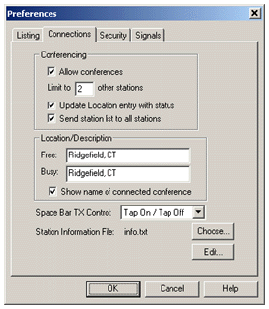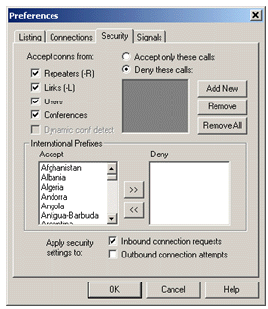Preferences
Preferences lets you customize several of EchoLink's features to suit your own taste. Choose one of the tabs along the top to view the Listing, Connections, Security, and Signals options. Each of these tabs is described in detail below.
Listing Tab
Items on the Listing tab control options for the station list area at the center of the EchoLink screen. This portion of the screen shows the callsign and location of each station currently on the system, and whether each is Busy (already in contact with another station) or On (ready for a new contact).
Update station list automatically: If this box is checked, the station list will refresh itself periodically. The box below specifies the number of seconds between each refresh.
Even while connected: If this box is checked, the automatic refresh will occur even while you are in contact with another station. On slower Internet connections, this may interfere with smooth performance of the audio, so you may wish to un-check it. If the box is un-checked, EchoLink will refresh the station list as soon as your contact is complete, unless less than 30 seconds has elapsed since the last refresh.
Show in Index View: This set of check boxes specifies which types of stations you wish to include in the Index View. Un-check any types of stations you do not wish to see. For example, if Stations Free is checked but Stations Busy is not, any station currently in contact with another will be omitted from the list.
Alarmed Only : If this box is checked, only those stations which have been added to your Alarms list will be displayed. For more information, see Tools Menu.
Show Alarms in pop-up window: If this box is checked, the Alarm Log window will automatically open each time an Alarmed station changes status, showing the station's callsign and status. You can also open or close the Alarm Log window from the View menu.
Add New QSOs to Favorites: If this box is checked, EchoLink will automatically add any stations to which you connect (or which connect to you) to your list of Favorites. (Favorites is one of the folders in the Explorer View). This is a convenient way of quickly re-connecting to a station you have spoken with recently.
Restore window size and position on startup: If this box is checked, EchoLink (on startup) will restore the main program window to the size and position at which you left it when it was last shut down. Otherwise, EchoLink always starts the program with the default size and position.
Connections Tab
The Connections tab includes controls for setting up the Conferencing features of EchoLink, and for setting text messages that appear during a contact.
Allow conferences: Check this box if you wish to allow more than one other station to connect to your EchoLink software at a time. In the box beneath, enter the maximum number of stations you wish to allow at once (not including yourself), to a maximum of 60.
The conferencing feature is not recommended if your PC is connected to the Internet over a slow link, such as a dial-up modem.
Update Location entry with status: If this box is checked, EchoLink will automatically update your station's entry in the Station List with a notation about the number of stations which have joined the conference. This allows other stations (who have not yet joined) to see the status of your conference. The notation is a number, in parentheses, added to the end of your Location/Description entry. Note that your station will be listed as On (rather than Busy) as long as the maximum number of connected stations has not yet been reached.
Send station list to all stations: If this box is checked, EchoLink will periodically update the text screen of each connected station with a list of all stations in the conference, with an arrow indicating the station that is currently speaking. This takes the place of the Station Information file, if one had been configured. This list will also appear on your own screen, even if this option is not selected.
Location/Description: The text in these two boxes will be displayed next your station's callsign in the Station List that is viewable by all stations on the system. Different text may be specified depending upon whether your station is Free (not in conversation) or Busy. Normally, however, these two items are the same.
Show name of connected conference: When this box is checked, each time you connect to a conference, EchoLink will automatically update your Location listing with the name of the conference, instead of your usual Location/Description. The listing (that other stations see) will become "In Conference XXXXX", where XXXXX is the callsign of the conference server or EchoLink conference you are connected to. (Note that this information will not appear in your own Station List until the next refresh.)
Space Bar TX Control: Choose between two options for how the space bar behaves as a TX control. When Tap On / Tap Off is selected (the default), tapping the spacebar once will switch to TX, and tapping it again will switch out. When Momentary is selected, press and hold the spacebar to TX, and release it to stop, like a conventional push-to-talk switch.
Middle Mouse Button: If you are using a three-button mouse (or a mouse with a clickable wheel), check this option to use the middle mouse button as a TX control as an alternative to the space bar.
Station Information File: EchoLink sends a text message to the other station when you establish a connection, which appears on the other station's screen. By default, this message is "Station XYZ", where XYZ is your callsign. Choose "Edit..." to make changes to this message, or choose "Choose..." to select some other file (besides info.txt) as your Station Information File.
If "Edit..." is grayed out (not available), it may mean that the station information file has been deleted. If this happens, use Windows Notepad to create a new one, then click "Choose..." to locate it so it can be used by EchoLink.
Show Alert when "Doubling": Normally, EchoLink does not allow two stations to transmit at the same time. However, due to Internet latency, it is possible for two stations to double if they begin transmitting at exactly the same moment. Enable this option to display a warning message in the Chat window if you are doubling with another station.
Security Tab
The Security tab controls features which prevent undesired access to your EchoLink system. This is particularly of interest in the Sysop mode, although the Security settings work in either mode.
Allow connections with: These four checkboxes control which types of stations you are willing to connect with. If a station that has been excluded tries to connect, EchoLink will immediately deny access, and make a special notation in the Log file.
Note: Un-checking "Conferences" will block connections only with "conference servers", and conferences running EchoLink version 1.1 or above.
If Conferences is un-checked, EchoLink will not allow connections with conference servers or EchoLink conferences. It is possible, however, to be connected with a station which later becomes a conference (when it connects with a third station). In this case, EchoLink will immediately disconnect, but only if Dynamic conf detect is checked.
Deny these calls: Select this option to set up a "banned list" of stations with which you do not want to connect. Any number of callsigns may be entered. To add a new callsign, choose Add New, then type the callsign (including any -L or -R suffix) into the blank space provided. To remove a callsign, select the callsign and choose Remove. Choose Remove All to clear all callsigns from the list. If the list is empty, no connections will be denied based on callsign.
Accept only these calls: Select this option to set up an "approved list" of stations with which you wish to allow connections exclusively. If this option is selected, no connection will be established with a station whose callsign is not listed. As with the Deny function, all callsigns must be fully spelled out, including any -L or -R prefix.
Note: Instead of (or in addition to) callsigns, you can also enter IP address ranges in this list, in CIDR notation. This is sometimes useful as a short-cut for accepting or denying several different stations who use the same Internet provider.
International Prefixes: Use this feature to control access to your station according to the international prefix of the other station's callsign. For convenience, EchoLink manages these prefixes internally, and displays only the names of each country in these lists. This feature has been provided to help you comply with your country's rules regarding reciprocal control-operator privileges or third-party traffic restrictions.
The countries in the Accept list are countries with which connections will be allowed; those in the Deny list will be denied. To move a country from one list to the other, select the country name (by clicking on it), then choose one of the two arrow buttons in the center.
For example, if the only country in the Deny list is "United States", any station with a U.S. callsign prefix (AAA-ALZ, KAA-KZZ, NAA-NZZ, or WAA-WZZ) will be denied access; all others will be allowed.
Note that the countries listed are those in the ITU Prefix list. There is no recognition of DXCC entities for this feature, and thus no distinction between offshore territories and their host nations. Also, EchoLink has no way to detect when a callsign is being used outside of its country of origin.
Apply Security settings to: Use these two checkboxes to direct EchoLink to apply the above security settings to connections coming in to your station, to connections initiated by your station, to both, or to neither. For example, if both boxes are un-checked, the Security settings have no effect, and all connections are permitted.
Signals Tab
The Signals tab lets you change the sounds (signals) produced by EchoLink when certain events occur. EchoLink includes a set of default sounds, and you can silence them or substitute your own WAV files for each. These settings apply to Single-User mode only.
The signals are as follows:
- Connected: A station has just connected (either at your own request or theirs).
- Disconnected: A station has just disconnected.
- Alarm: A callsign in the Alarm list has just appeared (or changed status) in the Station List.
- Over: A station with which you are speaking has just finished a transmission (and has turned it over to you).
- Text Msg: A station to which you are connected has just typed a text message (in the Chat window).
To preview any of the signals, click on the small loudspeaker button.
These signals are used only in Single-User mode. In Sysop mode, a separate set of signals is used..



